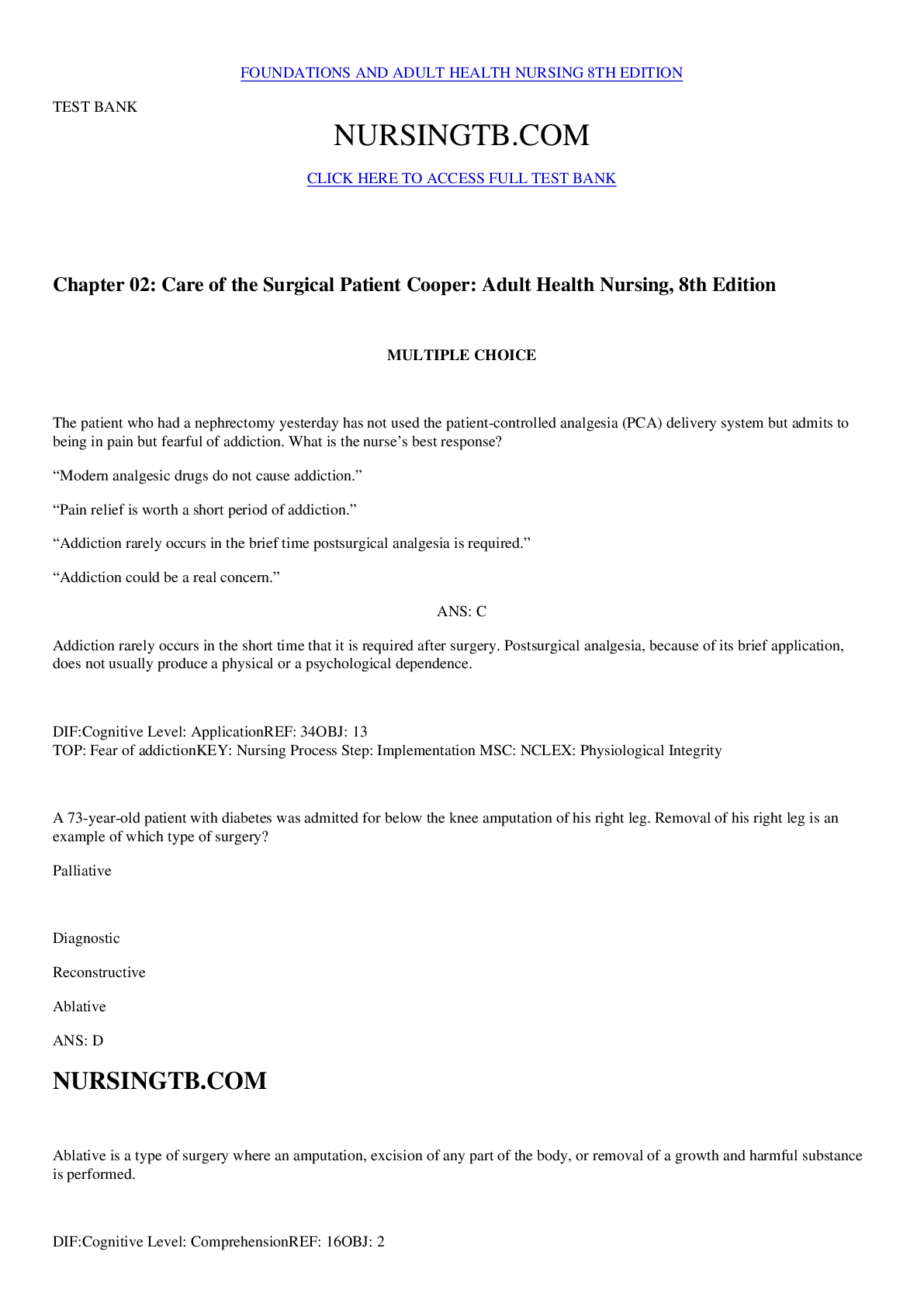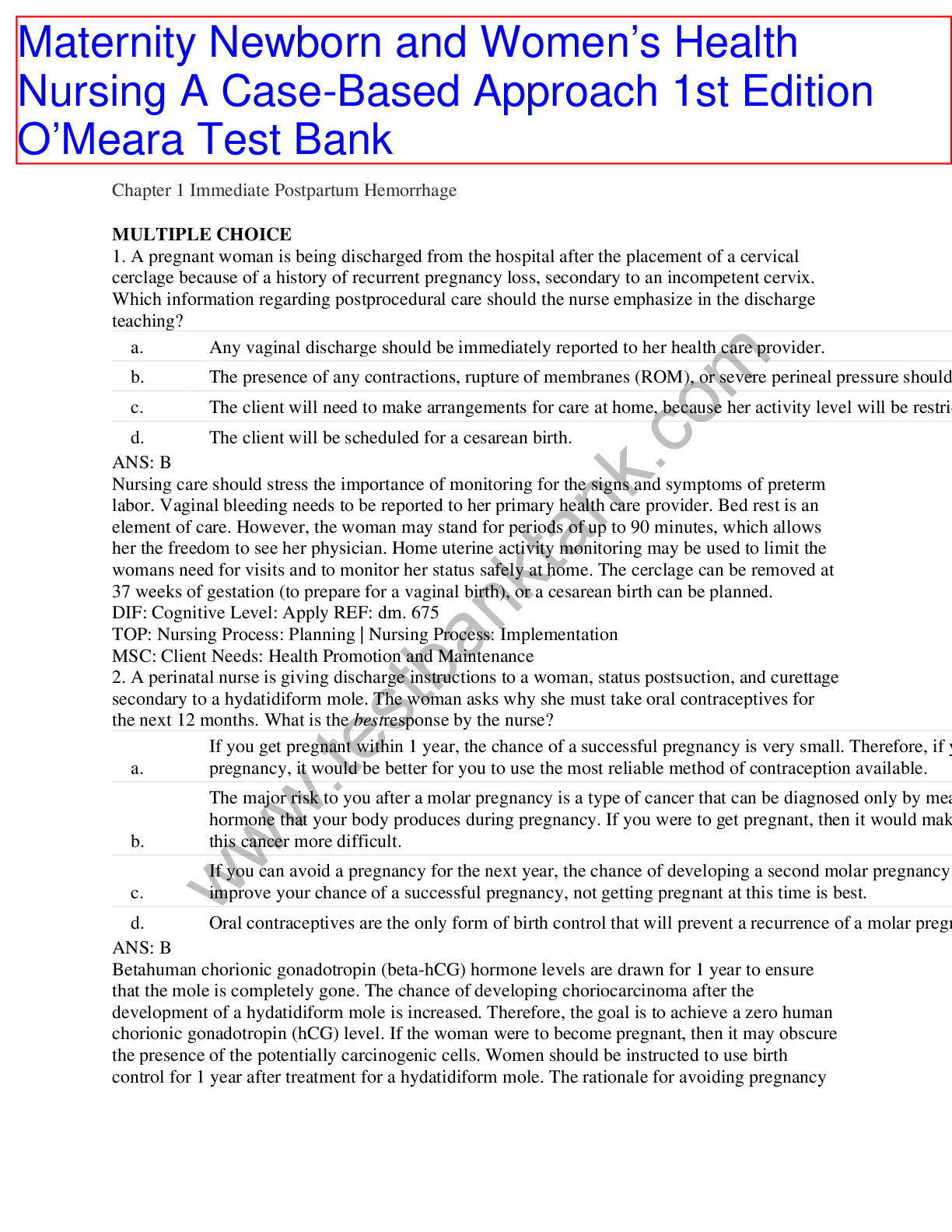*NURSING > TEST BANK > Chamberlain college of nursing test bank pediatric nursing a case based approach 1st edition by gann (All)
Chamberlain college of nursing test bank pediatric nursing a case based approach 1st edition by gannon tagher lisa knapp
Document Content and Description Below
Pediatric Nursing – A Case-Based Approach 1st Edition Tagher Knapp Test Bank Chapter 1: Bronchiolitis 1. Which intervention is appropriate for the infant hospitalized with bronchiolitis? a. Posit... ion on the side with neck slightly flexed. b. Administer antibiotics as ordered. c. Restrict oral and parenteral fluids if tachypneic. d. Give cool, humidified oxygen. ANS: D Cool, humidified oxygen is given to relieve dyspnea, hypoxemia, and insensible fluid loss from tachypnea. The infant should be positioned with the head and chest elevated at a 30- to 40-degree angle and the neck slightly extended to maintain an open airway and decrease pressure on the diaphragm. The etiology of bronchiolitis is viral. Antibiotics are given only if there is a secondary bacterial infection. Tachypnea increases insensible fluid loss. If the infant is tachypneic, fluids are given parenterally to prevent dehydration. 2. An infant with bronchiolitis is hospitalized. The causative organism is respiratory syncytial virus (RSV). The nurse knows that a child infected with this virus requires what type of isolation? a. Reverse isolation b. Airborne isolation c. Contact Precautions d. Standard Precautions ANS: C RSV is transmitted through droplets. In addition to Standard Precautions and hand washing, Contact Precautions are required. Caregivers must use gloves and gowns when entering the room. Care is taken not to touch their own eyes or mucous membranes with a contaminated gloved hand. Children are placed in a private room or in a room with other children with RSV infections. Reverse isolation focuses on keeping bacteria away from the infant. With RSV, other children need to be protected from exposure to the virus. The virus is not airborne. 3. A child has a chronic cough and diffuse wheezing during the expiratory phase of respiration. This suggests what condition? a. Asthma b. Pneumonia c. Bronchiolitis d. Foreign body in trachea ANS: A Asthma may have these chronic signs and symptoms. Pneumonia appears with an acute onset, fever, and general malaise. Bronchiolitis is an acute condition caused by respiratory syncytial virus. Foreign body in the trachea occurs with acute respiratory distress or failure and maybe stridor. 4. Which nursing diagnosis is most appropriate for an infant with acute bronchiolitis due to respiratory syncytial virus (RSV)? a. Activity Intolerance b. Decreased Cardiac Output c. Pain, Acute d. Tissue Perfusion, Ineffective (peripheral) ANS. A Rationale 1: Activity intolerance is a problem because of the imbalance between oxygen supply and demand. Cardiac output is not compromised during an acute phase of bronchiolitis. Pain is not usually associated with acute bronchiolitis. Tissue perfusion (peripheral) is not affected by this respiratory-disease process. Rationale 2: Activity intolerance is a problem because of the imbalance between oxygen supply and demand. Cardiac output is not compromised during an acute phase of bronchiolitis. Pain is not usually associated with acute bronchiolitis. Tissue perfusion (peripheral) is not affected by this respiratory-disease process. Rationale 3: Activity intolerance is a problem because of the imbalance between oxygen supply and demand. Cardiac output is not compromised during an acute phase of bronchiolitis. Pain is not usually associated with acute bronchiolitis. Tissue perfusion (peripheral) is not affected by this respiratory-disease process. Rationale 4: Activity intolerance is a problem because of the imbalance between oxygen supply and demand. Cardiac output is not compromised during an acute phase of bronchiolitis. Pain is not usually associated with acute bronchiolitis. Tissue perfusion (peripheral) is not affected by this respiratory-disease process. Global Rationale: Activity intolerance is a problem because of the imbalance between oxygen supply and demand. Cardiac output is not compromised during an acute phase of bronchiolitis. Pain is not usually associated with acute bronchiolitis. Tissue perfusion (peripheral) is not affected by this respiratory-disease process. Chapter 2: Asthma 1. The nurse is caring for a child hospitalized for status asthmaticus. Which assessment finding suggests that the childs condition is worsening? a. Hypoventilation b. Thirst c. Bradycardia d. Clubbing ANS: A The nurse would assess the child for signs of hypoxia, including restlessness, fatigue, irritability, and increased heart and respiratory rate. As the child tires from the increased work of breathing hypoventilation occurs leading to increased carbon dioxide levels. The nurse would be alert for signs of hypoxia. Thirst would reflect the childs hydration status. Bradycardia is not a sign of hypoxia; tachycardia is. Clubbing develops over a period of months in response to hypoxia. The presence of clubbing does not indicate the childs condition is worsening. 2. Which finding is expected when assessing a child hospitalized for asthma? a. Inspiratory stridor b. Harsh, barky cough c. Wheezing d. Rhinorrhea [Show More]
Last updated: 1 year ago
Preview 1 out of 249 pages
Instant download
.png)
Buy this document to get the full access instantly
Instant Download Access after purchase
Add to cartInstant download
Reviews( 0 )
Document information
Connected school, study & course
About the document
Uploaded On
Jul 13, 2022
Number of pages
249
Written in
Additional information
This document has been written for:
Uploaded
Jul 13, 2022
Downloads
0
Views
105


.png)








